Time to clock in? Find the tried and true time management strategies that online learning experts use and recommend for staying on track of work and development.
Is your to-do list running over? Do you click the snooze button on training and administration tasks? Does your agency or program run on a team of one?
If so, you’re pretty typical for the kinds of people we work with at Talance. Many people who embark on a training program can easily feel overwhelmed, both at the beginning and as the program goes on.
You, like many of these people, could be struggling with time management.
Download Now: Free Virtual Training Planning Template
Here’s some good news: you can learn time management skills. We surveyed our seasoned experts for tips on how to manage your time. Follow some of the tips we provide below, and you’ll find that your day becomes more organized and you can get on with your work training remote learners.
What is time management for training programs?
Time management refers to your ability to plan and finish your tasks in a timely and efficient way. For training program administrators, this means folding in managing activities with your regular day-to-day tasks, such as:
- Enrolling and disenrolling
- Answering learner questions
- Checking completion and certification status
- Reviewing tasks
- Managing forums
Or any manner of other tasks that you need to complete related to an ongoing program.
Our top 12 time management strategies for remote training admins
- Plan your week
- Set priorities
- Plan for interruptions
- Practice
- Schedule tasks around your most productive times
- Designate (and) organize your work area
- Stop multitasking
- Set deadlines
- Devise an accountability plan
- Break projects into milestones
- Set clear goals
- Answer questions before they’re asked
1. Plan your week
One of the biggest time-sinks is sitting around figuring out what to do next. Instead, prep your week ahead and map out an action plan for everything you need to do. Friday or Sunday are good days to do this.
Review the syllabus for important deadlines and account for the time grading each assignment should take. While you may not have an exact timeframe, try to be realistic or use past assignments for reference. Then block off actual time on your calendar to get the work done. Include deadlines and check-ins with learners on your calendar too.
It’s a smart idea to plan a daily check-in to keep work from piling up at the end of the week. A good practice is to schedule at least an hour of dedicated focus time on the program per day.

2. Set priorities
Time management is largely about managing priorities and expectations. Many people get distracted by endless to-do lists and struggle to check anything off. As you plan your week, prioritize the tasks that need to be completed instead of the ones that would be nice to complete. Of course, play and rest matter as well, so be sure to include them in your schedule.
There’s a famous strategy called the 1 3 5 rule that helps you break down your to-do list based on the size of the task you’ll be doing — so you schedule 1 big thing, 3 medium things, and 5 smaller things per day.
To prevent stretching yourself thin, keep an eye for open tasks you can assign to someone else on your team. It might surprise you how many tasks you can outsource to someone else on your team.
3. Plan for interruptions
You’ll likely not be able to work uninterruptedly for more than a few hours. it’s just not realistic to expect to do so. To prevent spending more time than you should on unexpected interruptions, it’s best to account them into your schedule. Watching a three-hour seminar? Plan for a quick break halfway to get some water and move your body for a few minutes.
Other temptations when working online include social media, your smartphone, and even your inbox. Instead of “banning” them and then checking them mindlessly, set specific times to check without interrupting your workflow.
4. Practice
If you’re offering a live element, such as a webinar or kickoff session, practice delivering your materials many times. This is true even if you have your training materials written out. Practice will make you a better communicator.
When you do this, note where you should be at 5-, 10- or 15-minute intervals so you’re on track. Practice in front of a colleague or your supervisor and ask for feedback. At the same time, fellow trainers give feedback, so they polish each other presentations. Meanwhile, they make sure that there’s a clock in the training room.
5. Schedule tasks around your most productive times
Whether you’re a night owl or an early riser, use the times when you feel best to get the most focused work done.
One example of this may be scheduling all the tidying up and proofreading for Friday if you don’t think you’ll be able to write comments on assignment submissions then. After a while of managing online training, you’ll learn your rhythms and figure out a routine that feels good where you can produce your best work. Stick to it!
A good rule of thumb for time management is planning your day in 45-50 minute increments. It’s unlikely that you’ll be able to focus for much longer than that without a little break. Many fitness trackers even beep at the 50-minute mark to encourage you to move around for a minute or two.
6. Designate (and organize) your work area
A lot of people have a hard time with remote learning because they’re in the same space all day. One way to beat this is setting up a workstation to create a transition from personal to business. Much like you would during your commute.
It’s also important to keep your desk (or table) clean, stocked with work essentials, and free of distractions. A water bottle, some snack bars, and a pen and paper are all you need around when you’re working.
7. Stop multitasking
If you’re doing a lot at the same time, you’re being productive. Right? Not true. Multitasking means transitioning from one thing to another in a short span rather than devoting undivided attention to one thing. So you may end up taking longer to complete a task than you realize.
Studies show that it takes your brain a while to adjust when switching between tasks. So instead of juggling 2-3 things at once, you want to focus on one thing until you finish or for a fixed time. Try both approaches depending on what the task is. If you need a breather, find a good stopping point and take a break. You’ll be able to get back to another task for another block of time.
A lot of remote workers use a time management technique known as batching, where you schedule everything that’s similar in one block of time. For example, respond to all forum posts at once. Another method you can use is time blocking, where you set 1-2 hour blocks of time to a specific task, breaking your day into multiple blocks to work through your list.
8. Set deadlines
Deadlines count for your learners and for yourself. If you’re offering self-paced courses, even if you’re not pushing students to deliver, remember that it’s hard for people to complete work if they don’t have a time frame. Set deadlines for learners even if you feel like your syllabus is lenient. This keeps your and your participants’ workload even and manageable throughout the duration of the course.
9. Devise an accountability plan
Another important element of in-person training is holding learners accountable. This may not be the case in online training. Thus, personal accountability is crucial for effective time management.
If you need some outside motivation, consider enlisting a colleague to keep you accountable — and do the same for them. Regular check-ins make it easier to stick to your plan and do the work on time.
10. Break projects into milestones
Many of us find ourselves looking at a big project and unsure of how to tackle it. If it’s happened to you, an easy way to beat the overwhelm is to break the project into milestones that feel manageable and take things one step at a time.
A milestone can be anything from outlining a big paper to finishing the research for your presentation. As long as you can pinpoint a start and endpoint to it, it’s valid. Monday.com defines milestones as “checkpoints in a project that are used to identify significant events.
11. Set clear goals
If you can’t see a goal for the course or program, it will probably be harder to manage your time. In general, dropout rates in online learning are high, so it’s important that you share your program goals so learners are compelled and motivated by it.
Check out these tips for communicating more effectively in online courses for ideas on how to articulate.
12. Answer questions before they’re asked
Before your first program, brainstorm a list of questions you think people will ask, and write them down. Answer them in a kickoff presentation, and you can save time either referring to it or being clear before the training begins. As time goes by, create a list of frequently asked questions that you can post in a central place for learners to read.
Related: Ask Your Online Learners These Simple Questions
Time management is less about time and more about priorities
It’s easy to fall into a rabbit hole of endless trackers and task lists that may feel productive in practice but in reality, are only filling your day with busy work that would lead to very little results.
In reality, all the calendars in the world will mean little if you’re focused on the wrong things or unclear about what you need to focus on. That’s why the time management tips included in this list start with prioritizing and blocking out time for everything you need to accomplish.
Once you’re clear about what you need to do and why, your days will flow much better and it’ll be easier to get to what really matters.



